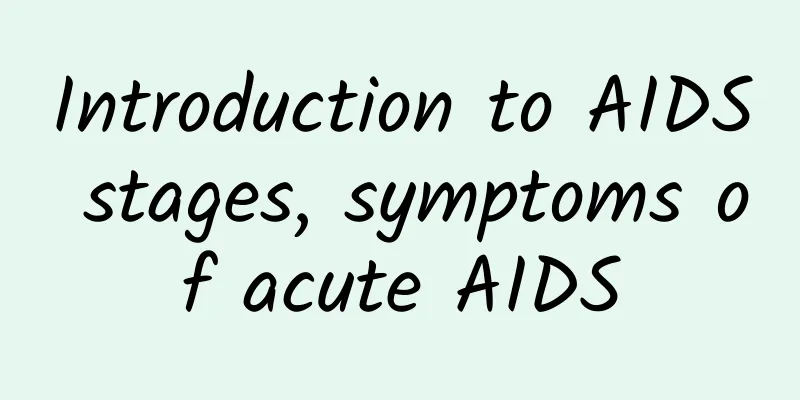Introduction to AIDS stages, symptoms of acute AIDS

|
AIDS can be divided into three stages: acute stage, asymptomatic stage, and AIDS stage. The symptoms of each stage are different. What are the symptoms of the acute stage of AIDS? How to prevent AIDS? 1. Symptoms of acute AIDS During the acute infection period, 75%-90% of new patients may have no symptoms at all. They are just HIV carriers, healthy in appearance, and have normal T4 cell counts in laboratory tests. They are HIV antibody positive 6 weeks after infection. Sometimes they have symptoms similar to infectious mononucleosis in the early stage, and sometimes they develop into chronic lymphadenopathy syndrome, which manifests as enlarged lymph nodes throughout the body. Systemic symptoms include fever, sore throat, sweating, joint pain, lymphadenopathy, and hepatosplenomegaly. Skin damage is mainly manifested as rashes, mostly non-itchy red maculopapular rashes, occasionally diffuse urticaria or water urticaria, and the rash is mostly on the face and trunk, and in severe cases, it can appear all over the body. About 9% of patients with damage to the nervous system may develop acute HIV meningitis, with clinical manifestations of fever, headache, vomiting and meningeal irritation signs. Cerebrospinal fluid examination shows an increase in mononuclear cells and increased protein content. Common gastrointestinal symptoms include nausea, vomiting, diarrhea, oral and esophageal candidiasis, etc. 2. How to prevent There is currently no effective vaccine to prevent AIDS, so the most important thing is to take preventive measures. The methods are: 1. Maintain self-discipline, do not engage in prostitution, and avoid premarital and extramarital sexual activity. 2. Drug use is strictly prohibited and syringes should not be shared with others. 3. Do not transfuse blood or use blood products without authorization. Use them under the guidance of a doctor. 4. Do not borrow or share personal items such as toothbrushes, razors, and shaving razors. 5. Using condoms is one of the most effective measures to prevent sexually transmitted diseases and AIDS during sexual intercourse. 6. Avoid direct contact with the blood, semen, breast milk and urine of AIDS patients to cut off the transmission route. |
<<: How accurate are HIV test strips?
>>: What are the ways of HIV transmission? What kinds of contact will not cause HIV transmission?
Recommend
What to do if you have a cold and fever? Simple ways to reduce fever
Catching a cold and having a fever is something t...
Pubic itching in men
The rash is common in the private parts of young ...
How to check for glans ulcer
Ulcers on the glans penis should be checked promp...
How to improve the sexual ability of men in their 40s?
At the age of 40, men have gradually entered midd...
What are the symptoms of insufficient Qi and blood in men?
Nowadays, many women have symptoms of insufficien...
What to do with kidney stone cysts, daily care and diet therapy
The kidney is one of the most important parts of ...
How to treat hair loss in boys?
Hair loss is a phenomenon that everyone will expe...
The effect of moxibustion on Baihui acupoint, and the three taboos to remember when doing moxibustion
Baihui acupoint is one of the many acupoints on t...
Routine physical examination items for men every year
Routine physical examinations can help us underst...
Symptoms of non-gonococcal chronic prostatitis
Non-gonococcal chronic prostatitis is mainly caus...
What are some nourishing medicinal foods for men?
The weather is getting colder and colder. When wi...
Types of left testicular pain
We all know that although many diseases sound the...
How do men control ejaculation?
Many men always have a lot of troubles during sex...
There are small bumps on the penis skin
Many men feel very embarrassed when small particl...
Why does urination hurt and bleed?
The phenomenon of stinging and bleeding when urin...









